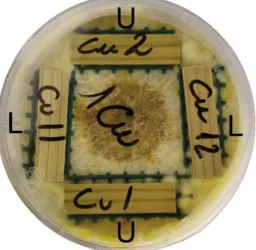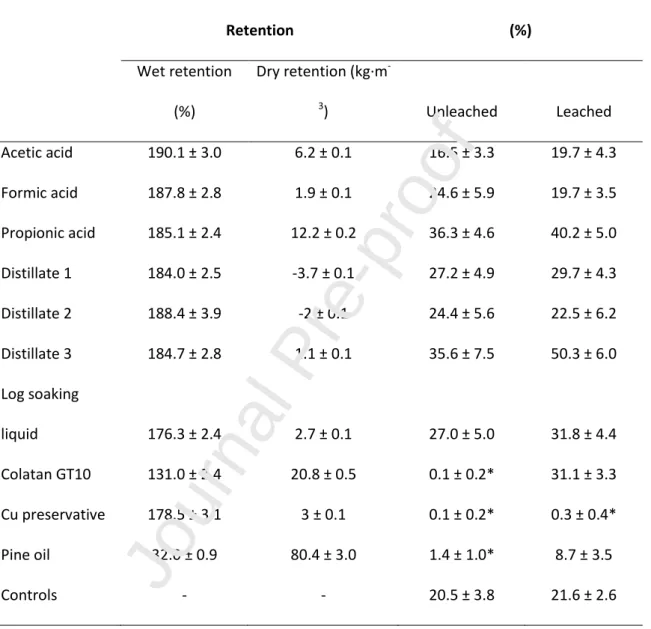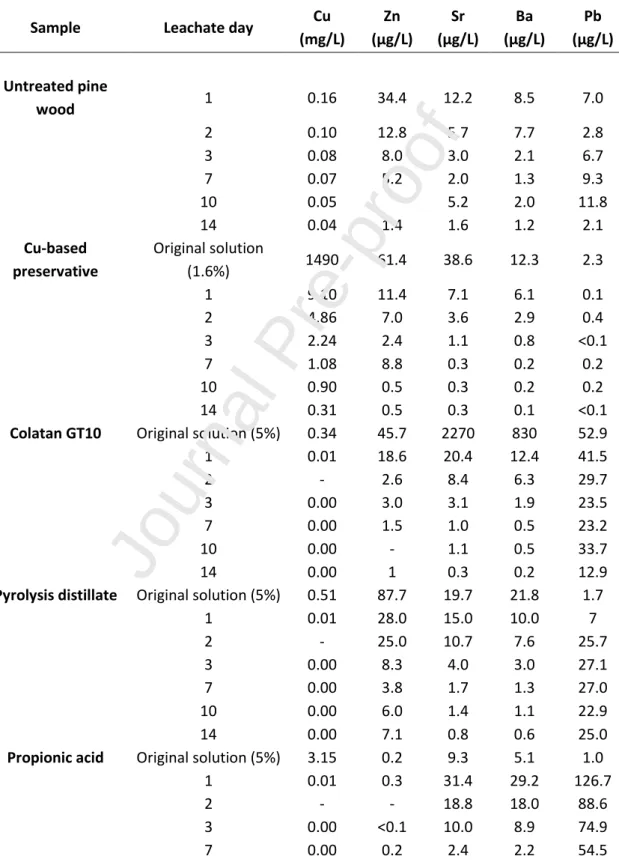Due to environmental concerns about toxic chemicals, stricter political pressure and efforts to mitigate climate change, and other global sustainability issues, chemical legislation is gradually restricting the use of traditional wood preservatives - usually based on formulations containing heavy metals - in Europe and North America (Gerengi et al., 2014). This drawback could be overcome by increasing the use of natural chemicals that exhibit antifungal activity, such as essential oils (Moutaouafiq et al., 2019) and stilbenes (Lu et al., 2016). Various types of tannins have already been proven to successfully inhibit wood-decomposing fungi (Anttila et al., 2013; Da Silveira et al., 2017; Tomak & Gonultas, 2018).
As such, tests on tannin-based formulations as a wood treatment have been ongoing for several years (Tondi et al., 2015). The inhibitory effects of pyrolysis distillates on wood rotting fungi are often attributed to their phenol content (Mourant et al., 2005; Temiz et al., 2010) and their organic acids (Barbero-López et al recently concluded that acetic and propionic acids, which are often found in pyrolysis distillates, can be used in the protection of boxwood.Despite several studies on natural preservation chemicals, leaching remains a problem for pyrolysis distillates (Temiz et al., 2010; Mohan et al., 2008), tannins (Sommerauer et al., 2019) and chitosan (Alfredsen et al., 2004).
In addition, little attention has been paid to the environmental effects of leachate despite the fact that many natural chemicals are toxic to living organisms, including some tannins (Libralato et al., 2011) and pyrolysis distillate compounds (Cordella et al., 2012). ). The disintegration test was performed according to the modified EN 113 mini-block procedure (Lu et al., 2016). The dry weight of the sapwood samples was then recorded at 50 °C to measure the weight loss caused by C.
A 5% (w/w) solution of the chemicals in 2% NaCl was prepared except in the case of log soaking liquid, in which a 5%
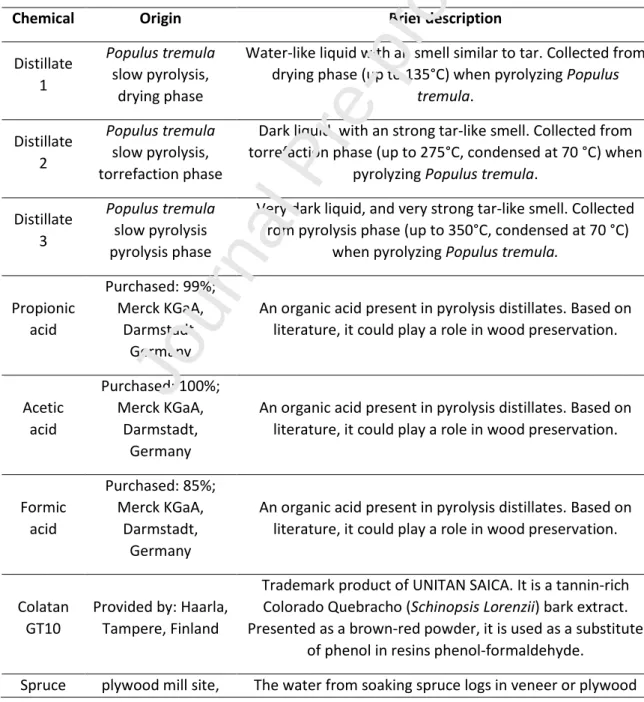
Statistical analysis
The stock calibration solution was diluted with HNO3 (TraceMetalTM grade, Fisher Chemical) and deionized water (USF Elga Maxima) to achieve a HNO3 concentration of 2.5%. Before ICP-MS measurements, the samples were diluted within the calibration ranges with HNO3 solution (final acid concentration 2.5%).
Results
Wood leaching and decay test
Acetic acid was the only organic acid that could remain in sapwood at higher concentrations than the copper-based preservative. The rest of the chemicals were retained in the sapwood samples in very low concentrations. The chemical treatments and leaching had a very significant effect on the mass loss caused by C.
In unleached samples, pine oil, Colatan GT10 and the copper-based preservative differed significantly from the controls, while only the copper-based preservative differed significantly from the controls and the rest of the chemicals after leaching (Table 2). Both references – the copper-based preservative and the pine oil – had the lowest mass loss of all the chemicals studied, with no mass loss for the copper-based preservative in both unleached and leached samples and with a mass loss of 1.5% in unleached samples. samples and 9% in leached samples for the sapwood samples treated with pine oil. Colatan GT10 prevented the mass loss of the unleached sapwood samples, but did not prevent the mass loss of the sapwood samples after leaching.
Acetic and formic acids did not cause a difference in the weight loss of the wood samples compared to the controls for both untreated and pickled samples, while propionic acid caused a greater weight loss than the controls, although the difference was not significant. Log irrigation fluids did not affect mass loss caused by fungal decay in either untreated or leached samples. An asterisk in the mass loss results indicates significant differences caused by the treatments within each leaching treatment.
Acute ecotoxicity of the test substances
No correlation was found between IC20 value and mass loss (wt-%) of soapwood specimens compared to control specimens (R2 = 0.305).
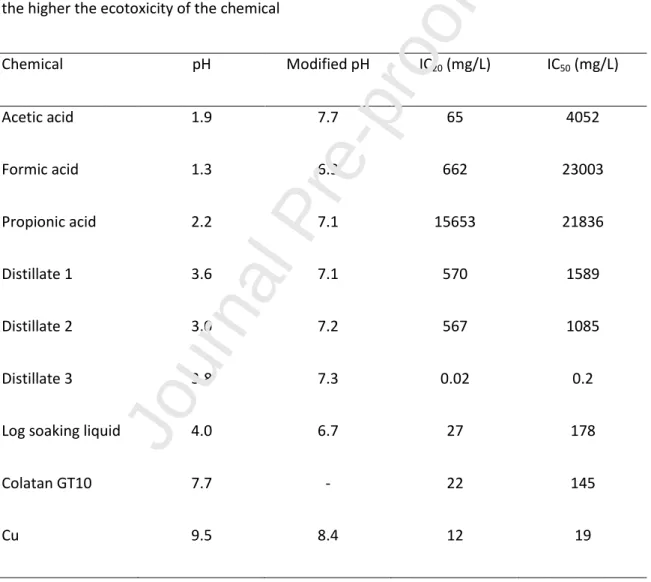
Elemental composition of the preservatives and leachates
Discussion
Kim et al., 2012; Shiny et al., 2017), although their effectiveness and composition varies depending on the pyrolyzed material and processing conditions (Barbero-López et al., 2019; Similar results were found by Mourant et al. 2005), of who found variable results depending on the different fractions and fungi tested against. A previous study conducted by Cordella et al. 2012) found that slow pyrolysis distillates can have acute toxic effects on humans and aquatic organisms.
A recent study showed that distillates produced by fast pyrolysis are of low toxicity in the aquatic environment (Campisi et al., 2016). This is most likely due to the significantly different chemical composition of the distillate fractions, as shown by Zhao et al. Other studied elements showed a similar trend, with the exception of lead (Pb), a systemic toxicant that can cause several types of harm to humans and the environment, even at low doses (Tchounwou et al., 2012; Jaishankar et al. 2014).
Leaching from wood is a continuous process that is affected by the exposure of wood to water and the acidity of the media (Hasan et al., 2010; Tao et al., 2013). Both copper and lead are harmful to the environment and humans (He et al., 2005; Brito et al., 2020), and their synergies can also increase the ecotoxicity of these leachates (Jung et al., 2014). The presence of elements such as lead can be responsible for the antifungal activity of some biological chemicals (Barbero-López et al., 2019), and their leaching into the environment can cause very negative effects.
Furthermore, larger specimens are usually better for more accurate results in leaching tests (Bahmani et al., 2016), which highlights the need for further investigation with industrial-sized wood specimens in long-term testing. of the weather. Furthermore, degradation products resulting in the environment due to leaching may also have an ecotoxic effect and affect the condition of water or soil ecosystems (Boxall et al. 2004), but their effects are not yet fully understood. . While the negative effects of treated wood on the environment are known (Xing et al. 2020) and the fluidity of commercial wood preservatives and their main reagent in contact with water are also known (Humar et al. 2007), the effects of -formulators have not been extensively studied and need further attention.
Biobased chemicals are promising wood preservatives as they are effective fungal inhibitors, but they present high heterogeneity depending on the raw material and are derived from wood (Teacă et al. 2019, Broda 2020). Testing different wood treatment methods would provide useful insights into the performance of bio-based chemicals on wood, such as coating them together with film formers, or performing an in situ polymerization of the chemical on wood (Teacă et al. 2019). It is important to note that ecotoxicity tests should be carried out for all chemicals used for wood preservation, as many chemicals that appear similar can have very different effects on the environment, as their composition varies depending on the material. first and processing temperature (Zhao et al. . 2020).
Conclusion
These co-formulations may be non-toxic when tested on a laboratory scale, but they may create degradation products or create synergies with other chemicals in the environment with high ecotoxicity. Future studies should focus on understanding the degradation and synergies of the leachate from treated wood, as well as its effects on the aquatic and soil ecosystems. The impregnation process used in this experiment was a modified whole-cell (Bethel) process, as it is common practice in the wood industry to use this method for water-soluble wood preservatives.
The various chemicals tested in this experiment may perform better when optimized protocols are followed for their use in wood. Colatan GT10 appears to be the most promising wood preservative of all the chemicals studied, and the ecotoxicity of this mixture of Quebracho tannins is less than that of copper-based wood preservatives. The results of just one type of test do not provide a complete picture of the ecological risks of these compounds.
The toxicity of some natural chemicals can be higher than that of commercial wood preservatives, which highlights the need for more systematic ecotoxicity testing in this area. If we ignore the ecotoxicity of biological wood preservatives, the environmental effects can be more severe than with traditional wood preservatives. Bahmani, M., Schmidt, O., Fromm, J., Melcher, E., Effect of wood sample size and species on chromium and copper leaching using different laboratory tests.
Antifungal activity of various vegetable-origin household waste extracts against wood-rotting fungi in vitro. Evaluation of the bioavailability of potentially toxic metals in surface sediments collected from a tropical river near an urban area. Wood preservatives – Test method for determining the protective effectiveness against wood-destroying basidiomycetes – Determination of the toxic values”.
Improvement of fungicidal properties and copper fixation of copper-ethanolamine wood preservatives using octanoic acid and boron. Water quality - Kinetic determination of the inhibitory effects of sediments, other solids and colored samples on the light emission of Vibrio Fischeri (kinetic . Luminescent bacterial test). Evaluation of antifungal effects of bio-oil prepared with lignocellulosic biomass using fast pyrolysis technology.
Regulation (EU) no. 528/2012 of the European Parliament and the Council of 22 May 2012 on the availability of biocidal products on the market and their use. Microbial remediation for the removal of inorganic contaminants from treated wood: recent trends and challenges.
